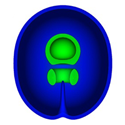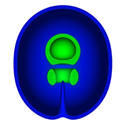Making monopoles
Magnets found in nature always come with a north pole and a south pole, but in the 1930s Dirac considered the possibility of monopoles with magnetic charge much like positive or negative electric charge. Discovery of such monopoles would have implications for cosmology and particle physics, to say nothing of fundamental quantum mechanics, but experimental searches in the 1970s and 1980s have proved fruitless. Physical analogies to monopoles have been found or predicted in several systems, however, including liquid crystals, quantum Hall devices, and superfluid helium, but nothing exactly like the Dirac monopole has yet been observed. In a paper in Physical Review Letters, Ville Pietilä and Mikko Möttönen at the Helsinki University of Technology, Finland, and the University of New South Wales, Australia, now calculate that in principle Dirac monopoles could be observed in the spin structure of a Bose-Einstein condensate.
At extremely low temperatures, alkali atoms condense to a single quantum state—the Bose-Einstein condensate—but still exhibit a spin that can be manipulated (called a spinor BEC). The authors propose that with the right kind of external magnetic fields, the ultracold atoms in the BEC, each with its own spin, could be arranged in a spherically nontrivial formation. Other external field configurations could be used to imprint different spin textures on the BEC, which are defects in the topology of the spin arrangement such as points or lines.
In this way, the BEC could be engineered to have a spin vorticity equivalent to the way magnetic field lines emanate from a Dirac monopole. If this theoretical proposal can be experimentally realized, researchers would have a testbench to examine how monopoles form, how long they live, and whether Dirac monopoles could be found in the wild. – David Voss





